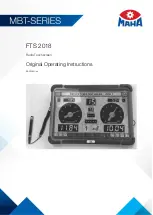
030-706-J0 Rev B
Page 12 of 26
6.3
Power System Chassis Ground
WARNING
For safety reasons, ensure the system is properly bonded to the building’s ground grid.
Both the shelf chassis ground (via power system chassis ground) and common return shall be connected to the
site ground to ensure correct operation of the system and to prevent drifting floating analog (especially current)
readings.
6.4
AC Feeder Protection/Sizing
To maximize system reliability, a dual AC feed divides the rectifiers into two groups to be supplied by two
separate feeds. A three feed option divides the rectifiers into three groups to be supplied by three separate feeds.
It is recommended for each feed to use a dedicated protection feeder breaker located at the AC distribution panel.
The feeder breaker can also act as the disconnect device for the connected modules.
Number of Rectifiers
on AC Feed
Circuit Breaker
Exact Value to Use (A)
90 deg. C Wire Gauge
to use at 30 deg. C
ambient (AWG)
1
15
12
2
20
12
3
30
10
Table A–Recommended AC supply configuration
6.5
AC Input Connections
CAUTION: AC input wires should be routed in flexible or rigid conduit as far away as possible
from the DC power wires to minimize EMI disturbances.
Remove the metal cover from the rear of the shelf to expose the wireway for input terminal blocks.
The wireway is designed for two customer-supplied 1” conduit fittings for AC supply located on the left side of the
shelf and two 3/4" conduit fittings on the rear.
Attach the conduit retainers to the wireway hole(s) and route the AC cables through. Secure the wires to the AC
input and chassis ground terminals as required. Tighten the cable connector to the AC cable (conduit similar).
Replace rear cover once all connections have been completed.
6.6
Calculating Output Wire Size Requirements
Wire size is calculated by first determining the appropriate maximum voltage drop requirement. Using the formula
below calculate the CMA wire size requirement. Determine the size and number of conductors required to satisfy
the CMA requirement.
CMA = (A x LF x K) / AVD, where:
CMA = Cross section of wire in circular MIL area
A = Ultimate drain in amps
LF = Conductor loop feet
K = 11.1 constant factor for commercial (TW type) copper wire
AVD = Allowable voltage drop
Check again that the ampacity rating of the cable meets the requirement for the installation application. Consult
local electrical codes (NEC, CEC, etc.) for guidelines. If required, increase the size of the cable to meet the code.
Summary of Contents for 030-706-J0
Page 2: ......
Page 14: ......
Page 47: ...03070605B__ sch 1 Fri Mar 04 14 39 15 2005 ...
Page 48: ...03070605B__ sch 2 Fri Mar 04 14 39 49 2005 ...
Page 53: ...03070705B__ sch 1 Fri Mar 04 14 43 46 2005 ...
Page 54: ...03070705B__ sch 2 Fri Mar 04 14 44 27 2005 ...
Page 55: ...03070705B__ sch 3 Fri Mar 04 14 44 54 2005 ...
Page 61: ......
Page 62: ......
Page 63: ......
















































